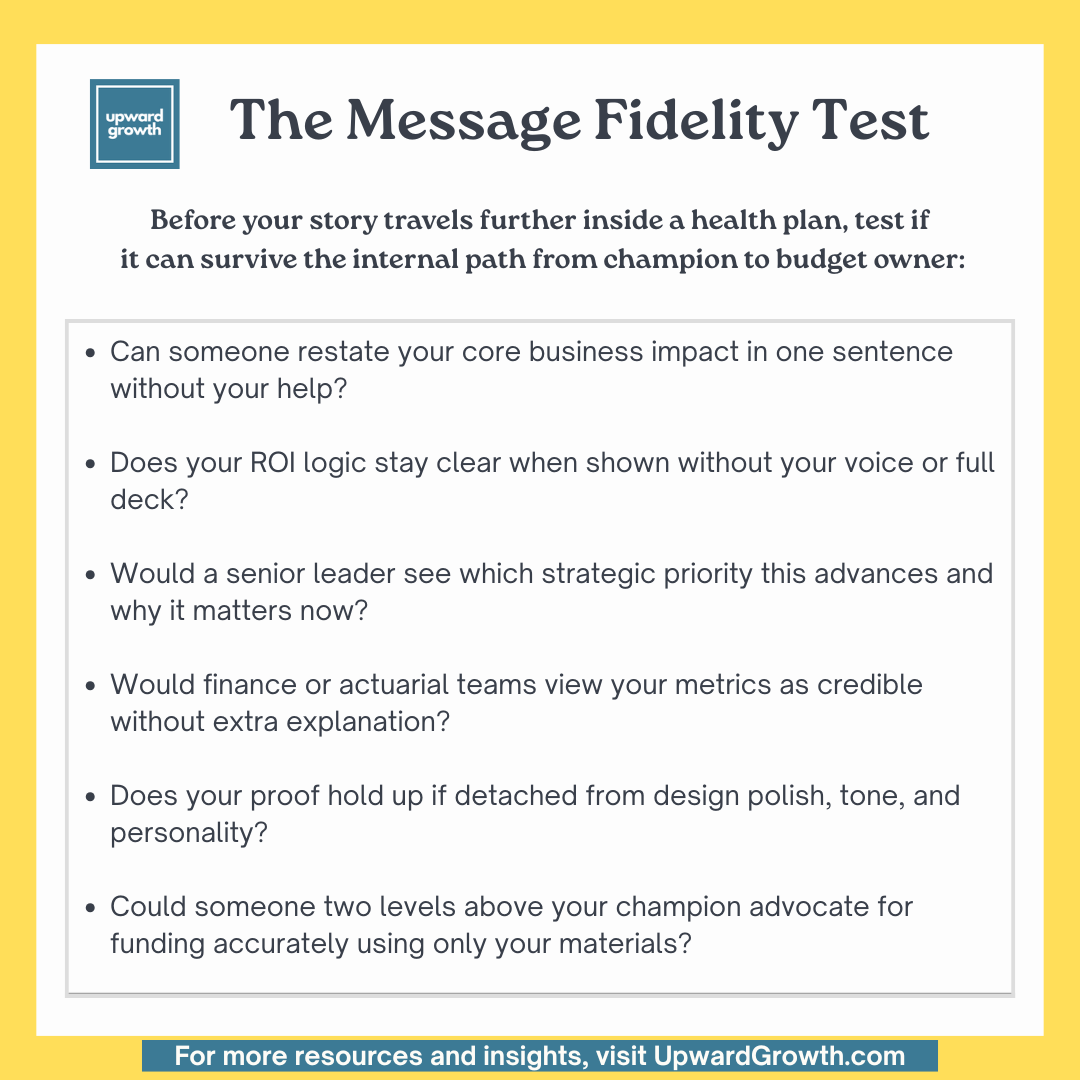How to Win Health Plan Decisions by Getting Your Message to the Top Intact
Use the Message Fidelity Toolkit to keep your story clear as it moves through complex health plan organizations
Upward Growth provides health tech leaders with the playbooks and proof to transform complex markets into real growth. Each week, we deliver clear, practical strategies on positioning, messaging, and growth, so leaders can close enterprise deals and build repeatable momentum.
🟦 Connect with the author, Ryan Peterson, on LinkedIn.
📩 Join the CEOs, GTM leaders, and investors already reading every Tuesday.
💡 Sponsorship opportunities are available: Inquire here
Where Enterprise Deals Break Inside Health Plans
Plenty of vendors lose deals to weak discovery, pricing gaps, or competition. Just as often, deals fade after early enthusiasm when the first buyer tries to carry the story beyond their level and up through the health plan.
The pattern is familiar. A Director or VP inside a health plan see the value in your solution and they say they’ll share it internally. A few weeks later they resurface, and (if you’re lucky) you get a short explanation saying it “lost momentum” or “never made it past finance.” Nothing was explicitly rejected, yet nothing moved.
What actually happened is straightforward: your story entered the plan’s internal forwarding chain and broke. Each internal forwarding hop stripped away the nuance of your solution’s messaging that made it persuasive. What finally arrived in the CFO’s inbox was an orphaned deck with no clear ROI logic or operational context. Your buyer had become your messenger, and the message didn’t survive the climb.
“Your buyer had become your messenger, and the message didn’t survive the climb.”
This internal forwarding chain is what I call the Message Ladder.
The Message Ladder is the invisible path your story must travel inside every enterprise account in order to reach the right people with the right message easily, accurately, and without you present. It is rarely linear and often crosses functions, departments, and budgets. Each handoff introduces new scrutiny and strips away context. If your message cannot survive this journey intact, even the strongest opportunities will lose momentum as they pass through successive decision points.
Why Message Decay Hits Health Plan Deals Harder
Health plan buying environments are unusually resistant to new solutions. No single executive owns the full decision. Budgets are planned far in advance. Any new initiative must clear strategic prioritization, budget approvals, operational risk reviews, and compliance sign-offs. Each demands proof that it is important enough, valuable enough, and reliable enough to displace existing commitments.
Most stories aren’t built for this environment, which is why Message Decay happens. The logic that works in a live meeting erodes as it moves through the system. Your buyer leaves the call energized, but their recap trims nuance and omits operational context. Their forwarded email reduces your story to outcome headlines with no financial logic. By the time finance or portfolio leaders see it, they often only see a product name and a cost, but no ROI framing, risk mitigation, or evidence that your solution can solve their most pressing challenges. What began as a compelling solution becomes a questionable expense.
You can see the pattern in how different types of vendors falter. SaaS teams tend to lead with dashboards, data models, and platform capabilities, but rarely address adoption risk or workflow disruption, so stakeholders doubt whether it will actually take hold. Tech-enabled service vendors often spotlight outcomes and people power without clarifying cost structure, scalability, or automation leverage, so stakeholders question whether it can scale. Both approaches create intrigue but not conviction, which stalls progress.
This erosion has real commercial consequences. Deals linger in pipeline, forecasts swing wildly, and champions burn out after spending political capital on proposals they can’t defend, all because the story lacks the structural integrity to survive multi-stakeholder environments.
The good news: this is solvable. When you understand how and where messages break, you can design them to stay intact. That’s the focus of the next section.
The Common Messaging Traps That Derail Health Plan Deals
Most vendor messaging is built to win live meetings, not to survive internal forwarding. Even capable teams end up designing their own stall points.
They write for the person in front of them rather than the broader system their story must traverse. They build decks that highlight features and outcomes without business context (no population size, acuity, operational effort, or capital fit). And when these stories reach a finance leader, that person scans for signals of attribution and scalability but instead finds persona-driven narratives (helping care managers, improving experience) with no clear link to the plan’s capital allocation framework.
Said plainly, vendors build stories to work only when they’re present, instead of engineering them to survive once they’re not.
Even great companies fall into the same traps:
Energy-dependent messaging: Relies on live charisma that evaporates once forwarded.
Persona-locked content: Speaks to end users instead of cross-functional budget approvers.
No ROI logic: Leaves champions unable to defend the financial case.
Proof-light packaging: Offers no metrics, references, or logos to counter risk bias.
The Message Fidelity Test
Before we get into how to fix this with the Message Fidelity Toolkit and walk through a mock health tech vendor example, take stock of where your current message stands.
Most vendor stories collapse the moment they leave the buyer’s hands. If yours can’t survive these questions without you present, it won’t survive the climb inside a health plan.
The next section walks you through the Message Fidelity Toolkit: the exact framework, templates, and real examples to rebuild your story so it survives the climb.
Using the Message Fidelity Toolkit to Win Enterprise Deals
Message decay is not random. It happens because most vendors build for the first meeting instead of the journey their story must survive. The Message Ladder is where many deals fail, and passing it requires a system. I call mine the Message Fidelity Toolkit. It turns your story into something your buyer can confidently move through the organization without you.
The Message Fidelity Toolkit
Fixing message decay requires more than polishing decks or adding proof points. You need a story built as a system so that it can survive separation, cross functionally, and hold up under senior decision-maker scrutiny.
The Message Fidelity Toolkit is comprised of four steps. We’ll walk through each step, then apply them in a mock vendor example so you can see how to build a message that can win health plan decisions by reaching the C-suite intact.
Step 1. Strategic Narrative
Define the strategic logic behind your solution.
Map the shift in the market, the problem in the current state, your solution mechanism, and the quantified outcomes metrics. This creates the backbone of your story so leaders can see why it matters.
Step 2. Concise ROI Framework
Translate value into budget language.
Distill the case from a full six-slide business model to a three-line summary to a one-line forward hook. If a buyer cannot repeat it cleanly in a finance meeting, it is not tight enough yet.
Step 3. Proof Anchors
Lower perceived risk with concrete evidence.
Include performance metrics, referenceable clients, executive quotes, cohort size and acuity, time period, and the operational footprint such as staffing and workflow changes. Anchors convert interest into confidence.
Step 4. Forwardable Templates
Package the story so your buyer can carry it forward.
Create short internal cover notes that bundle the narrative, ROI, and proof in a form your buyer can copy and send to their leadership. This is how the message actually travels through the Ladder intact.
Applying the Message Fidelity Toolkit
To make this concrete, we’ll apply all four steps to a mock vendor scenario, complete with the internal cover notes and email templates buyers actually forward, so you can see how to build a message that wins approval at the highest levels of a health plan.
The full mock scenario and ready-to-send templates are just below — upgrade to a paid subscription to keep reading.



